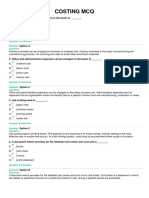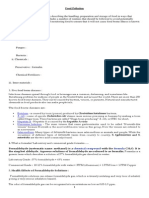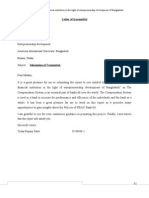Inventory Management Quiz Questions
Inventory Management Quiz Questions
Uploaded by
Shihab KhanCopyright:
Available Formats
Inventory Management Quiz Questions
Inventory Management Quiz Questions
Uploaded by
Shihab KhanOriginal Description:
Copyright
Available Formats
Share this document
Did you find this document useful?
Is this content inappropriate?
Copyright:
Available Formats
Inventory Management Quiz Questions
Inventory Management Quiz Questions
Uploaded by
Shihab KhanCopyright:
Available Formats
Print Inventory Managment flashcards | Easy Notecards
http://www.easynotecards.com/print_list/14701
Inventory Managment
1. Though one objective of inventory management is to minimize the cost of holding inventory, name an additional goal. HINT: It is the reason we have safety stock Customer service level. 2. To provide satisfactory levels of customer service while keeping inventory costs within reasonable bounds, what two fundamental decisions must be made about inventory? Timing and size of orders. 3. An example of inventory holding cost is the cost of moving goods to temporary storage after receipt from a supplier. True False FALSE These are ordering costs. 4. Interest, insurance, and opportunity costs are all associated with holding costs. True False TRUE These are holding costs. 5. The A-B-C approach involves classifying inventory items by unit cost, with expensive items classified as A' items and low cost items classified as C' items. True False FALSE A-B-C approach classifies inventory according to some measure of importance. 6. EOQ inventory models are basically concerned with the timing of orders. True False FALSE EOQ models are concerned with the size of orders. 7. Carrying cost is a function of order size; the larger the order, the higher the inventory carrying cost. True False TRUE Larger order quantities lead to higher inventory carrying cost 8. ROP models indicate to managers the time between orders. True False FALSE ROP models indicate when, with regard to on-hand inventory, orders should be placed. 9. When to order can be calculated by the ROP and expressed as a quantity. TRUE ROP models indicate when, with regard to on-hand inventory, orders should be placed. 10. The rate of demand is an important factor in determining the ROP. True False TRUE The demand rate multiplied by the lead time is a major part of the ROP. 11. Safety stock is held because we anticipate future demand. True False FALSE Safety stock is held because we anticipate fluctuations in future demand or in lead time 12. Variability in demand and/or lead time can be compensated for by safety stock. True False TRUE Safety stock can be used to accommodate these. 13. ROP models assume that demand during lead time is composed of a series of dependent daily demands. True False FALSE ROP models assume that demand during lead time is composed of a series of independent daily demands. 14. Profit margins tend to be inversely related to inventory turns. True False TRUE This is typically the case. 15. In the fixed-order interval model, the order size is the same for each order. True False FALSE Order size varies from order to order in a fixed-order interval model. 16. The fixed-order interval model requires a continuous monitoring of inventory levels. True False FALSE The fixed-order interval model leads to periodic monitoring of inventory levels. 17. The single-period model can be very helpful in determining how much to order. True False
1 of 4
3/6/2014 11:55 PM
Print Inventory Managment flashcards | Easy Notecards
http://www.easynotecards.com/print_list/14701
TRUE The single-period model helps determine how many to order. 18. Monitoring inventory turns over time can be used as a measure of performance. True False TRUE Greater turnover often implies better performance. 19. The basic EOQ model ignores the purchasing cost. True False TRUE Only if quantity discounts are offered does purchasing cost enter into EOQ analysis. 20. In a single period inventory model, if demand exceeds stocking level, a __________ occurs Stockout 21. Does safety stock eliminate stock outs? No. It only decreases the likelihood 22. The calculation of safety stock requires knowledge of __________ and __________. Service level and lead time variability 23. What are the two basic issues in inventory management? 1. What to order 2. How much to order 24. All stock outs must be avoided. True False FALSE Most of the time it would be too costly to avoid all stockouts. 25. Which of the following is not one of the assumptions of the basic EOQ model? A. Annual demand requirements are known and constant. B. Lead time does not vary. C. Each order is received in a single delivery. D. Quantity discounts are available. E. All of the above are necessary assumptions. D. Quantity discounts are available 26. Which of the following interactions with vendors would potentially lead to inventory reductions? A. reduce lead times B. increase safety stock C. less frequent purchases D. larger batch quantities E. longer order intervals A. Reducing lead times 27. Dairy items, fresh fruit and newspapers are items that: A. do not require safety stocks B. cannot be ordered in large quantities C. are subject to deterioration and spoilage D. require that prices be lowered every two days E. have minimal holding costs C. subject to deterioration and spoilage 28. Which of the following is least likely to be included in order costs? A. processing vendor invoices for payment B. moving delivered goods to temporary storage C. inspecting incoming goods for quantity D. taking an inventory to determine how much is needed E. temporary storage of delivered goods E. temporary storage of delivered goods 29. In an A-B-C system, the typical percentage of the number of items in inventory for A items is about: A. 10 B. 30 C. 50 D. 70 E. 90 A. 10 30. In the A-B-C classification system, items which account for fifteen percent of the total dollar-volume for a majority of the inventory items would be classified as: A. A items B. B items C. C items D. A items plus B items E. B items plus C items C. C items 31. In the A-B-C classification system, items which account for sixty percent of the total dollar-volume for few
2 of 4
3/6/2014 11:55 PM
Print Inventory Managment flashcards | Easy Notecards
http://www.easynotecards.com/print_list/14701
inventory items would be classified as: A. A items B. B items C. C items D. A items plus B items E. B items plus C items A. A items 32. The EOQ model is most relevant for which one of the following? A. ordering items with dependent demand B. determination of safety stock C. ordering perishable items D. determining fixed interval order quantities E. determining fixed order quantities E. determining fixed order quantities 33. In a supermarket, a vendor's restocking the shelves every Monday morning is an example of: A. safety stock replenishment B. economic order quantities C. reorder points D. fixed order interval E. blanket ordering D. fixed order interval 34. In the basic EOQ model, if lead time increases from five to 10 days, the EOQ will: A. double B. increase, but not double C. decrease by a factor of two D. remain the same E. none of the above D. Remain the same because EOQ is about how much to order, not when to order 35. Which one of the following is not generally a determinant of the reorder point? A. rate of demand B. length of lead time C. lead time variability D. stockout risk E. purchase cost E. purchase cost 36. If no variations in demand or lead time exist, the ROP will equal: A. the EOQ B. expected usage during lead time C. safety stock D. the service level E. the EOQ plus safety stock B. expected usage during lead time This is because R= dL 37. Which one of the following is implied by a "lead time" service level of 95 percent? A. Approximately 95 percent of demand during lead time will be satisfied. B. Approximately 95 percent of inventory will be used during lead time. C. The probability is 95 percent that demand during lead time will exactly equal the amount on hand at the beginning of lead time. D. The probability is 95 percent that demand during lead time will not exceed the amount on hand at the beginning of lead time. E. none of the above D. The probability is 95 percent that demand during lead time will not exceed the amount on hand at the beginning of lead time. 38. All of the following are possible reasons for using the fixed order interval model except: A. Supplier policy encourages use. B. Grouping orders can save in shipping costs. C. The required safety stock is lower than with an EOQ/ROP model. D. It is suited to periodic checks of inventory levels rather than continuous monitoring. E. Continuous monitoring is not practical. C. The required safety stock is lower than with an EOQ/ROP model 39. Which of these products would be most apt to involve the use of a single-period model? A. gold coins B. hammers C. fresh fish D. calculators E. frozen corn C. fresh fish 40. The management of supply chain inventories focuses on: A. internal inventories
3 of 4
3/6/2014 11:55 PM
Print Inventory Managment flashcards | Easy Notecards
http://www.easynotecards.com/print_list/14701
B. external inventories C. both internal and external inventories D. safety stock elimination E. optimizing reorder points C. both internal and external inventories 41. An operations strategy for inventory management should work towards: A. increasing lot sizes B. decreasing lot sizes C. increasing safety stocks D. decreasing service levels E. increasing order quantities B. decreasing lot sizes 42. An operations strategy which recognizes high carrying costs and reduces ordering costs will result in: A. unchanged order quantities B. slightly decreased order quantities C. greatly decreased order quantities D. slightly increased order quantities E. greatly increased order quantities C. greatly decreased order quantities 43. The need for safety stocks can be reduced by an operations strategy which: A. increases lead time B. increases lead time variability C. increases lot sizes D. decreases ordering costs E. decreases lead time variability E. decreases lead time variability 44. With an A-B-C system, an item that had a high demand but a low annual dollar volume would probably be classified as: A. A B. B C. C D. none of these C. C items 45. The fixed order interval model would be most likely to be used for this situation: A. A company has switched from mass production to lean production. B. Production is done in batches. C. Spare parts are ordered when a new machine is purchased. D. Grouping orders can save shipping costs. E. none of these D. Grouping orders can save shipping costs. 46. Which one of these would not be a factor in determining the reorder point? A. the EOQ B. the lead time C. the variability of demand D. the demand or usage rate E. all are factors A. the EOQ
4 of 4
3/6/2014 11:55 PM
You might also like
- Multiple Choice Questions (MCQ) On Inventory ManagementDocument2 pagesMultiple Choice Questions (MCQ) On Inventory ManagementJoven Castillo80% (44)
- Chapter 10 - Test BankDocument33 pagesChapter 10 - Test BankKim Rudas100% (3)
- Question Bank - Materials ManagementDocument8 pagesQuestion Bank - Materials ManagementMY NAME IS NEERAJ..:):)100% (9)
- NormalDistribution ActivityAnswerKeyDocument18 pagesNormalDistribution ActivityAnswerKeyRafael Assunção86% (7)
- Supply Chain Management Solved MCQs (Set-3) PDFDocument6 pagesSupply Chain Management Solved MCQs (Set-3) PDFAshraf Saleem100% (2)
- Material Management MCQ With Answers PDFDocument4 pagesMaterial Management MCQ With Answers PDFVijay Nayak83% (6)
- Inventory Management: Multiple Choice QuestionsDocument3 pagesInventory Management: Multiple Choice QuestionsHazel Jane Esclamada33% (3)
- Material Management Study Material - MCQ For SailDocument16 pagesMaterial Management Study Material - MCQ For SailJason SNo ratings yet
- Quiz WarehousingDocument8 pagesQuiz WarehousingNhsyy100% (1)
- Purchase & Materials Management QuizDocument10 pagesPurchase & Materials Management QuizMuzammil Makandar83% (6)
- Supply Chain Management QuizDocument8 pagesSupply Chain Management QuizJose Sebastian100% (3)
- SCM MCQDocument11 pagesSCM MCQHEMALATHA SHANMUGAM75% (4)
- Package Title: Test Bank Course Title: Inventory and Warehouse Management Processes Question Type: Multiple-AnswerDocument17 pagesPackage Title: Test Bank Course Title: Inventory and Warehouse Management Processes Question Type: Multiple-Answerphong huynhNo ratings yet
- PPC MCQ QB 29.03.21Document20 pagesPPC MCQ QB 29.03.21jvanandhNo ratings yet
- Store Keeper PDFDocument2 pagesStore Keeper PDFbadaboy100% (1)
- Test Bank ProcurementDocument10 pagesTest Bank ProcurementRenad Adnan100% (1)
- CH13Document114 pagesCH13لبليايلاNo ratings yet
- Suite of Old American DancesDocument22 pagesSuite of Old American DancesRicardoVargasG100% (1)
- Michalowski Sumerian in Woodard The Cambridge Encyclopedia of The World's Ancient LanguagesDocument41 pagesMichalowski Sumerian in Woodard The Cambridge Encyclopedia of The World's Ancient Languagesruben100% (1)
- (HANDOUT) Unbeatable Growth Hacking StrategyDocument60 pages(HANDOUT) Unbeatable Growth Hacking StrategyHarnendio Aditia Nugroho0% (1)
- CH12-Inventory Management PoliciesDocument32 pagesCH12-Inventory Management PoliciesChristian John Linalcoso AranteNo ratings yet
- Inventory Management QuizDocument2 pagesInventory Management QuizPranav GoyalNo ratings yet
- Inventory MCQDocument6 pagesInventory MCQsan0z75% (4)
- Sample MCQDocument8 pagesSample MCQCHETAN KHAIRNARNo ratings yet
- Chapter 16: Multiple Choice QuestionsDocument5 pagesChapter 16: Multiple Choice QuestionsNagarajan Pitchandi100% (3)
- E-Book CW (Sup... Store Keeper)Document59 pagesE-Book CW (Sup... Store Keeper)pravin gaidhaneNo ratings yet
- Multiple Choice Questions MCQ On Inventory ManagementDocument2 pagesMultiple Choice Questions MCQ On Inventory ManagementVishal Gorivale100% (5)
- Costing Mcqs - 4: Just-In-Time (Jit) NeededDocument3 pagesCosting Mcqs - 4: Just-In-Time (Jit) Neededshivam kumar100% (1)
- Inventory ManagementDocument5 pagesInventory Managementanamika tripathi100% (1)
- MCQ RevisionDocument7 pagesMCQ RevisionAisha RahatNo ratings yet
- D) Just-In-Time Logistics .: Unit 4 - Inventory ManagementDocument10 pagesD) Just-In-Time Logistics .: Unit 4 - Inventory ManagementAjay KareNo ratings yet
- MCQ On Inventory ManagementDocument3 pagesMCQ On Inventory ManagementSugumar100% (4)
- Warehousing MCQsDocument10 pagesWarehousing MCQsMuhammad Bilal Raza50% (4)
- Inventory and SCM MCQsDocument20 pagesInventory and SCM MCQsSyed Abdul Wahab Gilani100% (3)
- Supply Chain Management Quiz PDFDocument7 pagesSupply Chain Management Quiz PDFbhartia100% (2)
- INVENTORY MODEL MCQsDocument5 pagesINVENTORY MODEL MCQsChristine joyce Magote0% (1)
- Costing MCQ 1 PDFDocument19 pagesCosting MCQ 1 PDFCostas Pinto100% (1)
- MCQ P Amp MMDocument15 pagesMCQ P Amp MMArjun Cardoza100% (1)
- MCQ - P& MMDocument13 pagesMCQ - P& MMpsrquark33% (3)
- Logistics Management MCQ With Answers PDFDocument4 pagesLogistics Management MCQ With Answers PDFMijanur Rahman100% (2)
- Economic Order Quantity QuestionsDocument11 pagesEconomic Order Quantity QuestionsAnkit Srivastava59% (17)
- Cost Accounting Multiple Choice QuestionsDocument41 pagesCost Accounting Multiple Choice QuestionsNasir Iqbal82% (11)
- MCQ 6Document5 pagesMCQ 6Eng-Ahmed Baasaay0% (1)
- Assignment of Material Management: Summary of Case StudyDocument2 pagesAssignment of Material Management: Summary of Case Studyraju_singh8917No ratings yet
- Pro Cur MentDocument31 pagesPro Cur Mentrizcst9759No ratings yet
- MCQ OSCM Unit 1 1 PDFDocument21 pagesMCQ OSCM Unit 1 1 PDFbhupesh joshi100% (1)
- Warehosing and Inventory Management New - 100 Mark QuestionsDocument5 pagesWarehosing and Inventory Management New - 100 Mark QuestionsNandhakumar S80% (5)
- Chapter-1: Introduction To Supply Chain Management Self Assessment QuestionsDocument48 pagesChapter-1: Introduction To Supply Chain Management Self Assessment QuestionsAhmed AliNo ratings yet
- Ware Housing Objective QuestionnaireDocument12 pagesWare Housing Objective QuestionnaireRithish Shanmugasundaram50% (2)
- Lecture - Materials ManagementDocument48 pagesLecture - Materials ManagementJoju Johny100% (1)
- Mcqs of TQMDocument16 pagesMcqs of TQMMuhammad Umair75% (4)
- MCQs of OSCM Ch. 1, OperationsDocument6 pagesMCQs of OSCM Ch. 1, OperationsChaitali GhodkeNo ratings yet
- Multiple Choice Questions Distrubution Logistic PDFDocument14 pagesMultiple Choice Questions Distrubution Logistic PDFYogesh Bantanur50% (2)
- Multiple Choice Questions (MCQ) On ForecastingDocument3 pagesMultiple Choice Questions (MCQ) On ForecastingJoven Castillo100% (10)
- Supply Chain ManagementDocument39 pagesSupply Chain Managementbasavarajrh75% (4)
- Chapter 5 Inventory Management Answer Key I. True or False Statements Black - TrueDocument14 pagesChapter 5 Inventory Management Answer Key I. True or False Statements Black - TruekNo ratings yet
- Inventory Management FAQDocument5 pagesInventory Management FAQsurenNo ratings yet
- CIPS Level 2 Inventory, Logistics and Expediting L2M5 Revision QuestionsDocument44 pagesCIPS Level 2 Inventory, Logistics and Expediting L2M5 Revision QuestionsaobakweabelNo ratings yet
- Quan Tri Ton KhoDocument28 pagesQuan Tri Ton KhoTran Anh ThuNo ratings yet
- MGMT 339 CH 13Document11 pagesMGMT 339 CH 13mic100% (1)
- Inventory, Logistics and Expediting QuestionsDocument21 pagesInventory, Logistics and Expediting QuestionsVanessa SaidiNo ratings yet
- Chapter 13 Inventory Management ReportDocument22 pagesChapter 13 Inventory Management ReportJanine SalesNo ratings yet
- Cpa Review School of The Philippines: ManilaDocument18 pagesCpa Review School of The Philippines: ManilaEnola HolmesNo ratings yet
- 157 37325 EA435 2013 4 2 1 Chap013Document43 pages157 37325 EA435 2013 4 2 1 Chap013Lee JNo ratings yet
- Environmental ScienceDocument6 pagesEnvironmental ScienceShihab KhanNo ratings yet
- Social Media - Good and Bad EffectDocument7 pagesSocial Media - Good and Bad EffectShihab KhanNo ratings yet
- BUS 101, HKM, North South University Chapter 9: Human Resource Management, Motivation, and Labor-Management RelationsDocument11 pagesBUS 101, HKM, North South University Chapter 9: Human Resource Management, Motivation, and Labor-Management RelationsShihab KhanNo ratings yet
- Instructor'S Resource Manual: Project Scheduling: Lagging, Crashing, and Activity NetworksDocument40 pagesInstructor'S Resource Manual: Project Scheduling: Lagging, Crashing, and Activity NetworksShihab Khan100% (1)
- Concept Cost of ProductionDocument1 pageConcept Cost of ProductionShihab KhanNo ratings yet
- REport On Brac BankDocument36 pagesREport On Brac Bankmehedihsn100% (1)
- c012p109 Climate Change in AsiaDocument8 pagesc012p109 Climate Change in AsiaShihab KhanNo ratings yet
- Education Board BangladeshDocument1 pageEducation Board BangladeshShihab KhanNo ratings yet
- Exim Bank Account TypesDocument11 pagesExim Bank Account TypesShihab KhanNo ratings yet
- Academic Probation System in Private UniversityDocument5 pagesAcademic Probation System in Private UniversityShihab KhanNo ratings yet
- Probability Definitions of StatisticsDocument19 pagesProbability Definitions of StatisticsShihab KhanNo ratings yet
- Colgate Vs PepsodentDocument22 pagesColgate Vs PepsodentShihab Khan0% (1)
- Tourism ManagementDocument9 pagesTourism ManagementShihab KhanNo ratings yet
- Goat Dairy Start-Up GuideDocument109 pagesGoat Dairy Start-Up Guide1rolandNo ratings yet
- ™ Aircraft - Engineer: Wooden Blades For V.P. AirscrewsDocument1 page™ Aircraft - Engineer: Wooden Blades For V.P. Airscrewsseafire47No ratings yet
- Advanced Level 1C Pronouns PresentationDocument8 pagesAdvanced Level 1C Pronouns PresentationniyazikorelNo ratings yet
- MCSL-216 Q1& Q2Document4 pagesMCSL-216 Q1& Q2preetam1610kumarNo ratings yet
- Document (29) Research Paper Chapter 1-3Document31 pagesDocument (29) Research Paper Chapter 1-3Elaysa Gajete100% (1)
- PATHOPHYSIOLOGY ECTOPIC PREGNANCY SoftDocument11 pagesPATHOPHYSIOLOGY ECTOPIC PREGNANCY SoftJann ericka JaoNo ratings yet
- Avrx 4100 WDocument236 pagesAvrx 4100 WFabio VieiraNo ratings yet
- Peperiksaan Sekolah Ketiga Tahun 2013 Bahasa Inggeris (Kertas 1) Tingkatan Peralihan Satu JamDocument6 pagesPeperiksaan Sekolah Ketiga Tahun 2013 Bahasa Inggeris (Kertas 1) Tingkatan Peralihan Satu JamJessie Yong Chui ShanNo ratings yet
- Maintenance ScheduleDocument10 pagesMaintenance ScheduleEnercom IndiaNo ratings yet
- The Feasibility of MalunggayDocument6 pagesThe Feasibility of MalunggayChrisha Mae M. SolainaNo ratings yet
- Design and Layout of Automatic Soil Moisture, Temperature and Humidity Regulation in PolyhouseDocument9 pagesDesign and Layout of Automatic Soil Moisture, Temperature and Humidity Regulation in PolyhouseEditor IJTSRDNo ratings yet
- Isolation of gDNA From Goat Spleen-1Document2 pagesIsolation of gDNA From Goat Spleen-1namratabaruah77No ratings yet
- Maternal and Child Nursing - Antepartum Practice Test With AnswersDocument6 pagesMaternal and Child Nursing - Antepartum Practice Test With Answersgelean payodNo ratings yet
- Ejercicios Present TensesDocument4 pagesEjercicios Present TensesAlejandra ÁlvarezNo ratings yet
- Project Number: Project Name: Location: Date: Prepared By: Floor Plan: Circuit Information: Total Length: Circuit Length Manifold Tube TypeDocument6 pagesProject Number: Project Name: Location: Date: Prepared By: Floor Plan: Circuit Information: Total Length: Circuit Length Manifold Tube TypepjimmyinahouseNo ratings yet
- Soal Eng Level 3 Omnas 12Document7 pagesSoal Eng Level 3 Omnas 12Adba ArsitekturNo ratings yet
- Phandelver and Below The Shattered ObeliskDocument244 pagesPhandelver and Below The Shattered ObeliskLinus JoyeuxNo ratings yet
- Antena - Dualband HWXX-6516DS1-VTM - Commscope-Obi PDFDocument3 pagesAntena - Dualband HWXX-6516DS1-VTM - Commscope-Obi PDFAndrei GhitiuNo ratings yet
- NSTP 1 Syllabus by Jeiar BurgosDocument9 pagesNSTP 1 Syllabus by Jeiar BurgosJoanna Rose BurgosNo ratings yet
- The Value of An Egg Essay - AKMYDocument2 pagesThe Value of An Egg Essay - AKMYEryel KaytNo ratings yet
- 240-62946386 Vehicle Driver Safety Management Procedure PDFDocument22 pages240-62946386 Vehicle Driver Safety Management Procedure PDFMAdrianRumayar100% (1)
- BBDS2043Document6 pagesBBDS2043Cassandra LimNo ratings yet
- Day 6 Book Inter Jan'25Document3 pagesDay 6 Book Inter Jan'25ap.quatrroNo ratings yet
- SPSS Tutorials-Data Entry, Data Screening, Validity, ReliabilityDocument23 pagesSPSS Tutorials-Data Entry, Data Screening, Validity, ReliabilityZahraNo ratings yet
- Some of The Notable Changes in The 2019 Revised Corporation Code (RCC)Document16 pagesSome of The Notable Changes in The 2019 Revised Corporation Code (RCC)Agapito De AsisNo ratings yet
- Jtag 1Document12 pagesJtag 1lavanyaNo ratings yet
- 16-1102 Views of The United StatesDocument32 pages16-1102 Views of The United StatesFlorian MuellerNo ratings yet







































































































